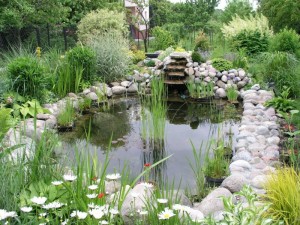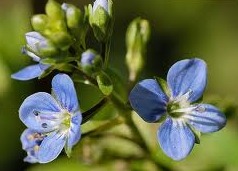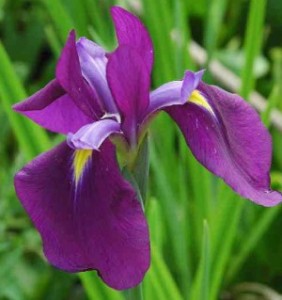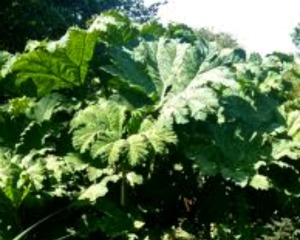





The purpose of an informal pool is to look natural and blend into the garden landscape. Unlike a formal pool, which will often faun a focal point and stand isolated in the middle of a lawn, an informal water feature should appear to be an integral part of the surrounding garden.
The area of open water, alight with waterlilies, may be a focal point, but it will also be the centre-piece of the planting scheme, which will flow naturally outwards into the garden.
 Much of the success of an informal water garden will be determined by the plants and features that tie it to its surroundings. The most common means of linking the pool to the landscape is either a rock garden or bog area. In many cases, the former results from a reluctance to dispose of the spoil from the pool, rocks being placed on the mound, which is then planted with alpines. This arrangement is rarely satisfactory, for it is not natural.
Much of the success of an informal water garden will be determined by the plants and features that tie it to its surroundings. The most common means of linking the pool to the landscape is either a rock garden or bog area. In many cases, the former results from a reluctance to dispose of the spoil from the pool, rocks being placed on the mound, which is then planted with alpines. This arrangement is rarely satisfactory, for it is not natural.
In fact, the excavated soil should be removed and any rock feature built independently. To take on a natural appearance, it should be designed to reproduce the characteristics of a moraine, an accumulation of rocks and free draining soil in which alpines may be grown. Rarely will it appear natural, or provide a suitable home for alpines, if it takes the form of a heap of sub-soil with protruding rocks.
Any rock feature should grow out of the landscape and not merely end at the water’s edge. It will be easier to achieve a natural effect if there is a sloping area behind the pool and, in some cases, the spoil from the pool can be redistributed to create a suitable land form from which a rock garden can be developed. This will look quite effective if allowed to spill into the water, provided a hard rock like millstone grit, which will not flake if frosted, is used.
Any adjacent bog area should be developed as the pool is constructed. Not only will it be easier to incorporate such a feature at this time, but also deciding upon the scale will be a simpler task if the pool is not already in place. For any bog garden to be effective, it should have an area at least half that of the pool, although there is no reason why it should not be twice or even three’ times the area of open water.
An informal pool can have almost any shape and configuration, but kidney and dumbbell shapes are the most popular of the pre-formed types. However, this type of water feature is also relatively easy to construct by other methods, which provide good opportunities for tasteful planting and ensuring that the pool rests easily in an informal setting.
Another essential element in achieving success with an informal pool will he the thoughtful use of natural materials.
It is wholly inappropriate to lay concrete or concrete paving in close proximity to the pool, since these materials will destroy any informal effect. Natural stone should be employed to provide visual relief or background, as necessary, and particularly where the relative formality of a path or edging is required. Genuine York paving, even though of formal appearance, blends quite naturally with an informal water garden design.
In many ways, the manner in which the edge of the pool is treated will determine the natural look, or otherwise, of the feature, whether it is disguised by planting or accentuated by hard landscape materials. Natural paving and rocks are good choices, but wood should not be rejected out of hand, while consideration can also be given to a cobble beach. If used discreetly, all such natural materials can add much to an informal water feature.
Of course, the planting scheme will determine whether or not an informal water garden is a success, for unlike other designs, it is the arrangement of plants in an unrestricted manner that gives the feature its informality. Indeed, provided the shape of the pool is compatible with good plant cultivation, the scale is suitable for the size of garden, and it is linked to its surroundings by an integral bog garden or rock feature, it could be said that planting is everything. A well planned informal water garden will provide the opportunity to grow a wide range of plants. In fact, the main reason for the feature’s existence may be for the enthusiastic gardener to take advantage of this diversity of plant life.
An informal pool must appear to be a relaxed and untroubled feature, the plants all growing in a carefree manner. At first sight, this may seem easy to achieve, but behind such success there must be considerable attention to detail.
The plants must be in proportion and of a vigour that is compatible with the space available. With a small pool, the undoubted desire to grow the bold, brown poker-like heads of the reedmace, or typha, should be restrained. At least, the typical tall growing species should not be entertained, for it dislikes life in a small container and, unless carefully secured, will topple into the pool at the slightest breeze. Instead, plant the shorter growing Typha minima, which rarely exceeds 45cm (18in) in height, and enjoy its fat brown poker heads. These will be produced freely on plants that are easy to manage; there is no point in fighting nature.
 Likewise, avoid those plants that creep and may jump from basket to basket. Using a creeper like Lysimachia nummularia to disguise the top of a container is fine, but having water mint (Mentha aquatica) or brooklime (Veronica beccabunga) leaping around could cause problems. These plants can invade a well planted margin, even when isolated in containers, and will swamp the unrestricted planting of a soil covered margin completely.
Likewise, avoid those plants that creep and may jump from basket to basket. Using a creeper like Lysimachia nummularia to disguise the top of a container is fine, but having water mint (Mentha aquatica) or brooklime (Veronica beccabunga) leaping around could cause problems. These plants can invade a well planted margin, even when isolated in containers, and will swamp the unrestricted planting of a soil covered margin completely.
If such plants are avoided, and those that seed freely deprived of their flower stems immediately, management will be greatly simplified. Beware of musk, or mimulus, and the various water plantains, beautiful plants though they may be. Along with some of the common rushes, these are very generous in producing self sown seedlings.
Deciding on which plants should be grown together is very much a matter of personal taste, but several are quite beautiful and look natural in an informal setting. Contrasts of flowers, as well as flowers and foliage, should be considered, along with the beauty that a solitary example can display against a watery background, particularly in the centre of the pool. A waterlily will look majestic on still amber water, but will simply become part of a floral mix if fighting for its place among encroaching marginal plants or exuberant floaters.
With an informal setting, where the margins of the pool are likely to be heavily and colourfully planted, often extending into a surrounding marsh or bog area, simplicity in the water is the keynote. Choose a waterlily with plain green leaves and single-coloured blossoms. Avoid those that have mottled foliage or flowers that change colour with age, resulting in several blossoms of different colours on one plant at the same time. A simple white or pink waterlily, especially if it is also heavily fragrant will provide stability, dignity and an essential focal point for the water feature.
The margins of the pool are rather like the frame of a picture, but with an informal water garden, they often reach out into a hog garden. Wherever possible, the two should merge and not be obviously separate entities, although by their very nature, they will be managed as such. Some plants, like the marsh marigolds, umbrella leaf and Himalayan cowslip, will easily bridge the gap, since they may be grown in both bog and margin without difficulty.
Of these plants, the marsh marigolds are the most useful, for they are among the first to flower in spring, bringing sparkling colour to a dull landscape. Use their bold mounds of gold and white blossoms as focal points, but position them so that as blossoms fade and the leaves start to look jaded, other vegetation takes over.
Follow these plants with aquatic irises: bold sentinels that produce lovely flowers in a wide array of colours during midsummer. Use their upright clumps of bright green, sword-like leaves for summer structural planting, and do not clutter them with a tangle of other plants of looser habit.
 Where the main purpose of the water garden is to provide a means of growing as many different plants as possible, the primary aims are to create the best conditions for the wellbeing of the plants and to ensure that they will live in harmony together. For the most part, these objectives are not difficult to attain, for the soil and water conditions that suit the broad range of aquatic plant life are easy to achieve and leave few plants wanting. A few aquatic and bog garden plants, such as the cotton grass (Eriophorum angustifolium) and the clematis-flowered iris of Japan (Iris ensata), demand acid conditions. However, these can be achieved easily by isolating the plants’ root systems, which can be done without being obvious.
Where the main purpose of the water garden is to provide a means of growing as many different plants as possible, the primary aims are to create the best conditions for the wellbeing of the plants and to ensure that they will live in harmony together. For the most part, these objectives are not difficult to attain, for the soil and water conditions that suit the broad range of aquatic plant life are easy to achieve and leave few plants wanting. A few aquatic and bog garden plants, such as the cotton grass (Eriophorum angustifolium) and the clematis-flowered iris of Japan (Iris ensata), demand acid conditions. However, these can be achieved easily by isolating the plants’ root systems, which can be done without being obvious.
Although the keen plant enthusiast’s pool often becomes the equivalent of a stamp collection, it need not look unattractive. While drifts of plants, which can create wonderful effects with their simplicity, may be excluded, by theming the plants, it is often possible to develop a collection that lives in visual harmony. The secrets of success lie in the flowering times and in associating plants by what they can do for each other, rather than for their colours and contrasts.
This means considering how mid-season plants can complement early flowering varieties, and later ones disguise the untidiness of both. Of course, it is not simply a matter of planting vigorous plants, of progressively later character, next to one another, for although hiding fading flowers and foliage is important, the plants should not he swamped. All plants require sufficient light during their growing period to perform and develop properly.
When choosing plants, it is also useful to have an overall theme in mind. Although the collection may be extremely diverse, it can be unified somewhat by careful planting. For example, all the bog garden ferns could be grown in a gloomy area, or candelabra primulas could be placed on a sunny peninsular. Large-leaved skunk cabbages can contrast with the substantial foliage of the giant Brazilian rhubarb (Gunnera manicata), while moisture loving grasses and decorative reeds and rushes can be kept together. This kind of theming can turn a disparate collection of plants into a scheme that is much more pleasing to the eye.
Space is also important, especially in the open water. Waterlilies, water hawthorn and the water fringe look very effective when surrounded by open water. It need not be much, but it should be retained, and any encroachment by floating foliage dealt with regularly. Keep submerged aquatics, such as water crowfoot (Ranunculus aquatilis) and water violet (Hottonia palustris), away from deep-water aquatics, for these punctuate the water surface with floating leaves and blossoms. Although charming in their own right, they can detract from the general scene and produce a very cluttered appearance.
 Floating plants can also be a distraction and, if possible, should be contained in one area of the pool. Although this may not always be practical, they should not be allowed to invade the space of other inhabitants of the open water.
Floating plants can also be a distraction and, if possible, should be contained in one area of the pool. Although this may not always be practical, they should not be allowed to invade the space of other inhabitants of the open water.
With a plant enthusiast’s pool, the open-water element, even if sparse, provides the opportunity to make the pool attractive and, to some extent, allows the background of margins and bog to be a little less ordered without looking too awful.
With the marginal shelves and bog garden, initial consideration should be given to structural planting, using visually important characters like the giant-leaved Gunnera manicata, the majestic royal fern (Osmunda regalis) and the decorative rush (Schoenoplectus lacustris tabernaemontani ‘Albescens’). If these can be planted so that they provide a background or focal point, to an extent, the other plants can be regarded as dressing.
Copyright © www.100flowers.win Botanic Garden All Rights Reserved